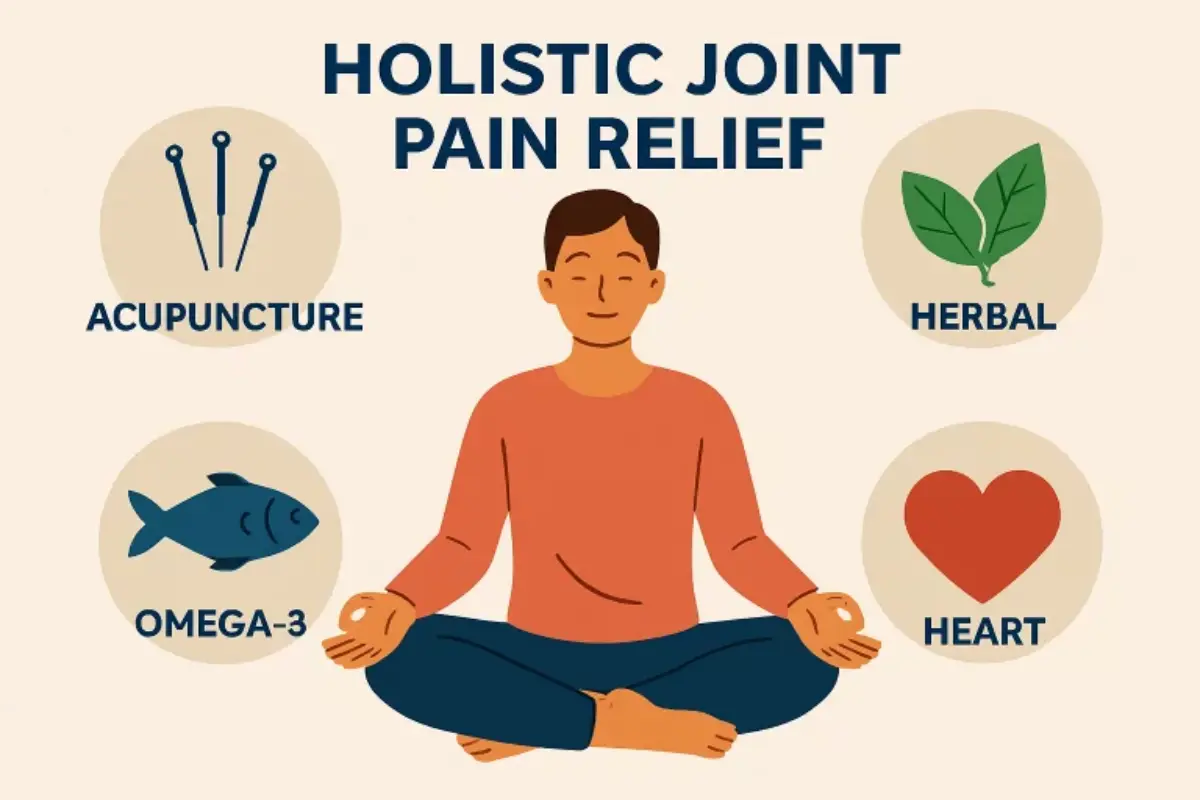Millions of individuals experience joint pain, a chronic condition that can diminish everyday functionality, limit mobility, and impact overall quality of life. While conventional treatments like non-steroidal anti-inflammatory drugs (NSAIDs) are widely available and generally effective, their long-term use often carries risks of significant side effects, such as gastrointestinal issues, cardiovascular complications, and dependency.
As a result, more people are turning toward alternative and complementary therapies to find safer, sustainable solutions. Fortunately, there are several effective joint pain treatment options that extend beyond standard pharmaceuticals and are backed by both scientific research and clinical experience.
From time-honored holistic practices to innovative physical modalities and nutritional strategies, exploring these alternatives allows individuals to create a comprehensive, personalized approach to joint pain management. Understanding the range of available options can empower you to choose methods that align with your unique needs, medical history, and lifestyle preferences—helping you regain control and improve your quality of life.
Contents
Acupuncture: An Ancient Practice for Modern Relief
Acupuncture stands out as a hallmark of traditional Chinese medicine and remains popular in integrative medicine clinics worldwide. This ancient practice involves inserting fine, sterile needles into specific points on the body, which is thought to help balance energy flow (Qi) and stimulate the body’s self-healing abilities.
Over recent decades, medical researchers have confirmed that acupuncture can effectively reduce chronic pain, including joint pain linked to conditions like osteoarthritis, rheumatoid arthritis, and fibromyalgia. Patients often report not only diminished pain but also improved joint flexibility, a decrease in swelling, and less reliance on prescription painkillers.
Notably, a feature by AARP highlights that acupuncture provides outcomes similar to those of conventional medical interventions while carrying substantially fewer side effects, which is particularly beneficial for older adults or those with multiple health concerns. Acupuncture is also recognized for its calming effects, helping reduce anxiety and improve sleep, further supporting its value as a holistic pain management tool.
Herbal Remedies: Nature’s Anti-Inflammatories
For centuries, people worldwide have harnessed the healing power of plants to address inflammatory and painful conditions. Today, modern research continues to highlight the potent anti-inflammatory and analgesic effects of certain herbs, making them attractive options for those who wish to manage joint pain naturally without harsh medication. Among the most widely studied and effective herbal remedies are:
- Turmeric (Curcumin): Turmeric is a golden-hued spice whose main active compound, curcumin, boasts powerful anti-inflammatory and antioxidant effects. Several clinical studies have demonstrated that curcumin can significantly reduce joint pain and improve mobility in people with arthritis. According to a systematic review, turmeric may offer pain relief comparable to certain NSAIDs but lacks their common digestive and cardiovascular risks, making it a gentler, long-term solution for chronic joint pain.
- Ginger: Known both as a culinary spice and medicinal root, ginger is celebrated for its strong anti-inflammatory properties. Clinical studies show that ginger extract can lessen osteoarthritis-related knee and joint pain, decrease stiffness, and improve overall joint function. Ginger is also favored for its soothing effects on digestion and its relatively low risk of side effects, making it well-tolerated by many patients.
- Willow Bark: Used for millennia in various cultures, willow bark contains salicin—a natural compound similar to the active ingredient in aspirin—that works to alleviate pain and inflammation. Scientific investigations suggest that willow bark can be especially helpful for reducing discomfort and stiffness in osteoarthritis sufferers.
While herbal remedies are generally regarded as safe, their effectiveness may vary among individuals, and potential interactions with medications should always be considered. Therefore, guided use under the supervision of a healthcare professional is recommended.
Mind-Body Techniques: Harnessing the Power of the Mind
Holistic joint pain management recognizes the essential link between mind and body. Mind-body techniques not only target the physical sensations of pain but also help mitigate the psychological burden, such as anxiety, stress, or depression, that often accompanies chronic pain. Incorporating these techniques can lead to more comprehensive and lasting relief. The most recognized include:
- Yoga and Tai Chi: Both yoga and tai chi focus on gentle, low-impact physical movement, breath control, and mindfulness. These ancient practices are particularly useful for enhancing flexibility, strengthening the muscles that support joints, improving balance, and reducing the risk of falls. Yoga and tai chi can significantly reduce symptoms in individuals with chronic low-back pain and osteoarthritis and improve both physical and mental well-being.
- Meditation and Mindfulness: Regular mindfulness practices, such as breath-focused meditation and body scans, have been shown to modify individuals’ perception of pain and enhance emotional resilience. These practices help reduce stress responses, lower pain-related anxiety, and improve patients’ coping strategies in the face of persistent discomfort.
Adopting mind-body techniques can be particularly empowering. They offer tools to self-manage symptoms, boost mood, and promote a more positive outlook even during challenging flare-ups.
Physical Therapies: Moving Towards Relief
Physical therapies are a cornerstone of non-pharmacological pain management, aiming not just to alleviate symptoms but to restore optimal function and prevent future injury. Hands-on interventions and professionally guided exercise regimens can make a substantial difference for those living with chronic joint pain:
- Massage Therapy: Through a combination of pressure, stretching, and targeted soft tissue manipulation, massage therapy relieves muscle tension, promotes relaxation, and increases blood flow to painful joints. Regular massage sessions may provide temporary yet meaningful relief for chronic low-back and other joint pain, supporting recovery and comfort.
- Physical Therapy: A customized exercise plan developed by a qualified physical therapist focuses on strengthening the muscles around affected joints, enhancing flexibility, and maintaining overall mobility. By improving biomechanics, posture, and movement patterns, physical therapy helps reduce pain, lowers the risk of re-injury, and allows patients to perform daily activities with greater ease and confidence.
Consistent engagement in these therapies can lead to long-term improvements, reduced dependency on medications, and enhanced independence.
Dietary Adjustments: Fueling Joint Health
Nutrition plays a pivotal role in inflammation regulation and joint health maintenance. A strategic, anti-inflammatory diet can have a profound effect on both symptom intensity and overall joint resilience. Some key dietary strategies include:
- Omega-3 Fatty Acids: These essential fats, primarily found in fatty fish (like salmon and sardines), flaxseeds, chia seeds, and walnuts, help decrease the production of inflammatory molecules in the body. Regular omega-3 intake is linked with reduced joint pain, morning stiffness, and swelling, particularly in autoimmune conditions such as rheumatoid arthritis.
- Anti-Inflammatory Diet: Emphasizing whole, unprocessed foods—fruits, vegetables, legumes, lean proteins, whole grains, nuts, and seeds—while minimizing refined sugars and unhealthy fats can help keep systemic inflammation in check. Many studies associate such dietary patterns with improved joint function and slower progression of degenerative diseases.
Proper hydration and weight management are also crucial, as maintaining a healthy body weight reduces excess pressure on the joints, thus minimizing pain and risk of further damage.
Consultation and Safety Considerations
While these alternative approaches offer promising paths to joint pain relief, it’s important to recognize that every person’s health profile and pain triggers are unique. Self-treatment without professional guidance may carry risks, particularly for those with underlying medical conditions or who are taking prescription medications.
For anyone considering starting new therapies—whether acupuncture, herbal supplements, or structured exercise programs—it’s essential to consult with qualified healthcare providers for a thorough assessment and tailored recommendations.
Additionally, a proper medical diagnosis should always be the first step for persistent or severe joint pain, as some causes require specific medical attention. Integrating effective joint pain treatment strategies with your clinician’s support maximizes safety and optimizes outcomes.
Exploring a comprehensive spectrum of alternative therapies—from acupuncture and herbal medicine to mindful movement, structured physical rehabilitation, and targeted dietary changes—provides a proactive approach to achieving lasting, sustainable relief from joint pain. With the right knowledge and appropriate medical support, you can empower yourself to create a personalized treatment plan on your path to improved joint health and enhanced quality of life.



